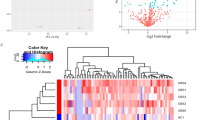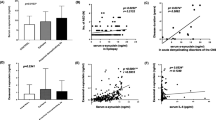Abstract
Background
Guillain-Barré syndrome (GBS) is a common acute immune-mediated inflammatory disorder affecting the peripheral nervous system (PNS) of humans. Studies in humans and in animal models revealed that neuropeptide Y (NPY) levels are altered in some neurodegenerative and neuroimmune disorders. Herein, we investigated the levels of NPY and cytokines in the serum of GBS patients and explored the roles of NPY in the disease severity and its short-term prognosis.
Methods
Twenty patients with GBS (case group) and twenty healthy individuals (control group) were enrolled in this study. NPY levels were analyzed by enzyme-linked immunosorbent assay (ELISA). The levels of pro- and anti-inflammatory cytokines (including interferon-γ (IFN-γ), interleukin (IL)-4, IL-10, IL-12p70, IL-17A, and tumor necrosis factor-α (TNF-α)) were analyzed using cytometric beads array (CBA). The clinical characteristics, disease severity, and short-term prognosis were compared between the two groups.
Results
Compared with the control group, the levels of NPY and cytokines were significantly increased in the serum of patients with GBS. NPY levels in the serum of GBS patients were correlated with the disease severity.
Conclusion
Our results suggest that NPY and cytokines are involved in the pathogenesis of GBS. The levels of NPY can help to predict the severity of the disease.



Similar content being viewed by others
Abbreviations
- GBS:
-
Guillain-Barré syndrome
- PNS:
-
Peripheral nervous system
- NPY:
-
Neuropeptide Y
- ELISA:
-
Enzyme-linked immunosorbent assay
- IFN-γ:
-
Interferon-γ
- IL:
-
Interleukin
- TNF-α:
-
Tumor necrosis factor-α
- CBA:
-
Cytometric beads array
- CNS:
-
Central nervous system
- MS:
-
Multiple sclerosis
- IVIg:
-
Intravenous immunoglobulin
- HFGS:
-
Hughes Functional Grading Scale
- MRC:
-
Medical Research Council
- SPSS:
-
Statistical Product and Service Solutions
- EAN:
-
Experimental autoimmune neuritis
- PE:
-
Phycoerythrin
- Th:
-
Helper T cell
- TGF-β:
-
Transforming growth factor β
References
Wakerley BR, Yuki N (2013) Infectious and noninfectious triggers in Guillain-Barre syndrome. Expert Rev Clin Immunol 9(7):627–639
Ziganshin RH, Ivanova OM, Lomakin YA, Belogurov AA Jr, Kovalchuk SI, Azarkin IV, Arapidi GP, Anikanov NA, Shender VO, Piradov MA, Suponeva NA, Vorobyeva AA, Gabibov AG, Ivanov VT, Govorun VM (2016) The pathogenesis of the demyelinating form of Guillain-Barre Syndrome (GBS): proteo-peptidomic and immunological profiling of physiological fluids. Mol Cell Proteomics 15(7):2366–2378
Zhang HL, Zheng XY, Zhu J (2013) Th1/Th2/Th17/Treg cytokines in Guillain-Barre syndrome and experimental autoimmune neuritis. Cytokine Growth Factor Rev 24(5):443–453
Ferreira R, Xapelli S, Santos T, Silva AP, Cristóvão A, Cortes L, Malva JO (2010) Neuropeptide Y modulation of interleukin-1{beta} (IL-1{beta})-induced nitric oxide production in microglia. J Biol Chem 285(53):41921–41934
Maeda K, Yasuda M, Kaneda H, Maeda S, Yamadori A (1994) Cerebrospinal fluid (CSF) neuropeptide Y- and somatostatin-like immunoreactivities in man. Neuropeptides. 27(6):323–332
Bedoui S, Miyake S, Lin Y, Miyamoto K, Oki S, Kawamura N, Beck-Sickinger A, von Hörsten S, Yamamura T (2003) Neuropeptide Y (NPY) suppresses experimental autoimmune encephalomyelitis: NPY1 receptor-specific inhibition of autoreactive Th1 responses in vivo. J Immunol 171(7):3451–3458
Levite M (1998) Neuropeptides, by direct interaction with T cells, induce cytokine secretion and break the commitment to a distinct T helper phenotype. Proc Natl Acad Sci U S A 95(21):12544–12549
Hughes RA, Newsom-Davis JM, Perkin GD et al (1978) Controlled trial prednisolone in acute polyneuropathy. Lancet 2:750–753
Kleyweg RP, van der Meché FG, Schmitz PI (1991) Interobserver agreement in the assessment of muscle strength and functional abilities in Guillain-Barré syndrome. Muscle Nerve 14:1103–1109
Reisin RC, Pociecha J, Rodriguez E, Massaro ME, Arroyo HA, Fejerman N (1996) Severe Guillain-Barre syndrome in childhood treated with human immune globulin. Pediatr Neurol 14(4):308–312
Thorsell A, Mathe AA (2017) Neuropeptide Y in alcohol addiction and affective disorders. Front Endocrinol (Lausanne) 8:178
Farzi A, Reichmann F, Holzer P (2015) The homeostatic role of neuropeptide Y in immune function and its impact on mood and behaviour. Acta Physiol (Oxf) 213(3):603–627
Kawamura N, Tamura H, Obana S, Wenner M, Ishikawa T, Nakata A, Yamamoto H (1998) Differential effects of neuropeptides on cytokine production by mouse helper T cell subsets. Neuroimmunomodulation 5(1–2):9–15
Gonzalez-Rey E, Delgado-Maroto V, Souza Moreira L, Delgado M (2010) Neuropeptides as therapeutic approach to autoimmune diseases. Curr Pharm Des 16(28):3158–3172
Puerto M, Guayerbas N, Alvarez P, De la Fuente M (2005) Modulation of neuropeptide Y and norepinephrine on several leucocyte functions in adult, old and very old mice. J Neuroimmunol 165(1–2):33–40
Dimitrijević M, Stanojević S (2013) The intriguing mission of neuropeptide Y in the immune system. Amino Acids 45(1):41–53
Singer K, Morris DL, Oatmen KE, Wang T, DelProposto J, Mergian T, Cho KW, Lumeng CN (2013) Neuropeptide Y is produced by adipose tissue macrophages and regulates obesity-induced inflammation. PLoS One 8(3):e57929
Painsipp E, Herzog H, Holzer P (2010) Evidence from knockout mice that neuropeptide-Y Y2 and Y4 receptor signalling prevents long-term depression-like behaviour caused by immune challenge. J Psychopharmacol 24(10):1551–1560
Myhr K (2003) Interleukin-10 promoter polymorphisms in patients with Guillain-Barré syndrome. J Neuroimmunol 139(1–2):81–83
Press ROV, Kouwenhoven M, Link H (2002) Non-T(H)1 cytokines are augmented systematically early in Guillain-Barré syndrome. Neurology 58(3):476–478
Hohnoki KIA, Koh CS (1998) Elevated serum levels of IFN-gamma, IL-4 and TNF-alpha/unelevated serum levels of IL-10 in patients with demyelinating diseases during the acute stage. Neuroimmunol 87(1–2):27–32
Nyati KKPK, Rizwan A, Verma A, Paliwal VK (2011) TH1 and TH2 response to Campylobacter jejuni antigen in Guillain-Barre syndrome. Arch Neurol 68(4):445–452
Bao LLJ, van der Meide P, Sw Z, Ljunggren HG, Zhu J (2002) The critical role of IL-12p40 in initiating, enhancing, and perpetuating pathogenic events in murine experimental autoimmune neuritis. Brain Pathol 12(4):420–429
Funding
This study was supported by grants from The First Hospital, Jilin University Changchun, China General Program of the National Natural Science Foundation (No. 81771299).
Author information
Authors and Affiliations
Corresponding author
Ethics declarations
This study was approved by the ethics committee of the First Hospital of Jilin University, Changchun, China.
Conflict of interest
The authors declare that they have no conflicts of interest.
Informed consent
Informed consent was obtained from all individual participants included in the study.
Additional information
Publisher’s note
Springer Nature remains neutral with regard to jurisdictional claims in published maps and institutional affiliations.
Electronic supplementary material
ESM 1
(XLS 30 kb)
Rights and permissions
About this article
Cite this article
Li, C., Luo, T., Cheng, Y. et al. The effects of IVIg therapy on serum levels of neuropeptide Y and cytokines in Guillain-Barré syndrome. Neurol Sci 41, 295–303 (2020). https://doi.org/10.1007/s10072-019-04063-3
Received:
Accepted:
Published:
Issue Date:
DOI: https://doi.org/10.1007/s10072-019-04063-3




